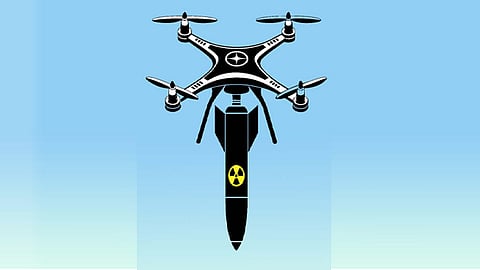A boost to drononomics
We are probably once again in the midst of a serious global crisis. There are prolonged wars (Russia-Ukraine or Israel- Hamas), short spell wars (Israel-Iran, where the US also pitched in; as also Indo-Pak fracas for nearly a week in May, which was really serious) and other kinds of skirmishes. The latest is between Thailand and Cambodia; also, muscle flexing signs are visible everywhere – unfortunate developments, one would say, considering the plethora of challenges (old ones and new), which the world has to deal with in the current century.
Every phase of a struggle, however, brings new sets of revelations and takeaways, which have long-term implications. We are not calling it a silver line of the recent clashes we have witnessed among some nations, but the fact is these skirmishes have proved beyond any doubt that ‘the art of war’ has assumed a new character. It has now clearly boiled down to your capability to score decisively in the sky rather than proving your superiority on the ground. The latter used to be the primary factor in the usual warfare, but no more. And, when it comes to the superiority in the sky, a clear winner that has emerged (as proved by the recent clashes) is drones. What had evolved as an effective surveillance tool (to monitor the borders) by some countries and later proved its utility for multiple applications (agriculture, logistics, surveillance, etc) has now turned into an effective weapon.
The point is: now also proving its utility as a weapon (cheap and effective) has put drones in a different stratosphere in terms of recognition of its utility value and there is no gainsaying that, in the coming years, you will notice a lot of innovations and countries will get into the race to develop an expertise in it. That brings us to our central point. Where do we stand in this sphere? And we do not need to probe it just in terms of the utility scale we may have attained in different verticals. But, more from the point of view of creation of a robust drononomics ecosystem, which may put us among leading countries in the world in controlled flying of these new age wonders. No prizes for guessing it right, China has already taken a leap over other countries and is an undisputed leader in drone components today.
It is no secret that India in the recent decade has managed to create a drone-led economic vertical system. And, in the recent short war with Pakistan, the indigenous drones also reportedly made important contributions. When it comes to economic utility, we are all aware of the government’s ‘drone didi’ campaign and there is no denying the fact, that in certain pockets, agri-input companies and farmers have begun using them for multiple benefits. It also goes to the credit of the government that there have been some decisive policy reforms in this area, such as Drone Rules 2021 and its subsequent amendments. The PLI system further supports drone manufacturing. And as a result of all these, several start-ups have popped up in the system. The entire Indian drone eco-system is expected to swell to $13 billion by 2030.
However, there are some serious challenges which need to be addressed urgently, if we are looking at other favourable outcomes like their integration with defence and becoming a global powerhouse. The biggest of them is: our inability for indigenous development of components. For drone manufacturing, more than 50 per cent of the components are imported now and these include such critical parts as sensors, flight controllers, autopilot system, etc. Most of them are sourced from China. And this is a serious bottleneck. Some of the leading start-ups have shown the ability to produce basic components. But, at a time when some nations are moving with great speed, making basic components is not enough. As drone industry stakeholders will tell you, the domestic R&D costs are still too high which is holding us back. Foreign components are also more vulnerable to cyber-attacks as their software codes are not controlled by Indian manufacturing units that are more like assembling points.
And, then there are other issues like restrictive regulatory provisions (beyond visual line of sight operations generally not allowed), lack of skilled manpower both for research and development plus operations, funding agencies backing drone ventures dealing with consumers and not those who are trying to make a mark in other sectors needing deep tech capabilities, etc. The component limitations, however, are the most critical blockade holding us back from moving to Stage II of developing a robust drone ecosystem. We had made a late beginning in the sphere, had shown a lot of promises initially and now is the time to go that extra mile to deliver on them.

